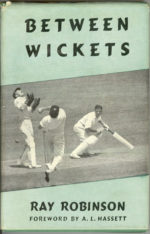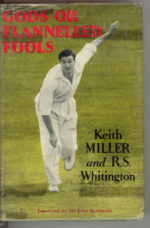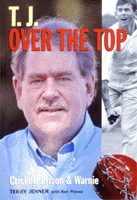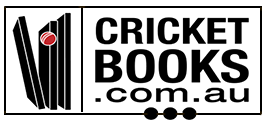Description
Co written with leading sportswriter and commentator Jon Anderson, hardback with dw.. Hoggie gets up close with the greatest pacemen in cricket history…. 17 extended interviews with many stars including Dennis Lillee, Malcolm Marshall, Wasim Akram, Allan Donald, Brett Lee and Curtly Ambrose
Additional information
| Published |
|---|
1 review for Hogg, Rodney and Jon Anderson – Speed Thrills
Add a review Cancel reply
You must be logged in to post a review.
Related products
-
Sale!

Nicholson, Rod – Merv Hughes, special price
Rated 0 out of 5$11.00$2.20 Add to cart -

Robinson, Ray – Between Wickets, 1946 first edition
Rated 0 out of 5$16.50 Add to cart -

Miller, Keith – Gods or Flannelled Fools (1953 Ashes tour)
Rated 0 out of 5$22.00 Add to cart -

Jenner, Terry – TJ Over the Top, Cricket, Prison & Warnie
Rated 0 out of 5$22.00 Add to cart



Ken Piesse –
Excerpts from Speed Thrills: Michael Holding
SUCH A MOVEMENT OF BEAUTY WAS MICHAEL
Holding’s approach to the bowling crease that batsmen were lulled into a false sense of security, doubting that someone so graceful could produce something so menacing.
But as his nickname of ‘Whispering Death’ implied, Holding was capable of extreme pace. That apt sobriquet was bestowed upon the Jamaican by English umpire Dickie Bird, because while he couldn’t
always hear Holding approaching the wicket, he had a bird’s-eye view of the carnage the man could cause. The cricket ball was released at speeds estimated to regularly be over 150km/h, and on certain days
around the magical 160km/h.
He arrived at a time when the finest group of fast-bowling talent ever was assembled by a single cricketing nation: Holding, Courtney Walsh
and Patrick Patterson from Jamaica; Sylvester Clarke, Wayne Daniel, Joel Garner and Malcolm Marshall of Barbados; Antiguans Curtly Ambrose and Andy Roberts; Ian Bishop of Trinidad and Tobago; and
the venomous Colin Croft of Guyana.
By unanimous verdict Holding was the quickest. His bowling in the first six to seven years of his Test career, which began in 1975, is considered
the equivalent of the great speed merchants before him, from Harold Larwood to Frank Tyson, Sir Wes Hall and Jeff Thomson. But with Holding or ‘Mikey’, as he is known and loved, there was a difference in
culture, his bowling more Beethoven than Rolling Stones.
It all began in Kingston, Jamaica, in a game only the locals would understand. Called ‘Catchy Shubby’, or ‘to push out of the way’, it just requires a bat, ball, anything for a wicket and open space. ‘It was a game
where you didn’t wear pads and you only got a bat when you bowled whoever was batting,’ Holding explains. ‘It wasn’t any good having them
caught, because the catcher would get to bat. If they decided to stand in front of whatever we used for the wicket – sometimes it was a tin pan or corrugated iron – and you hit them on the leg, there was no LBW.
So we bowled fast so that when it hit their leg it hurt.
‘And bowling fast did seem natural to me. I don’t think you can teach someone how to bowl really fast, although you can teach them some of the other aspects. I used to play other sports such as basketball
and running, but I was never that good at running [despite cricket commentators for years maintaining the myth that Holding could have run for his country]. Cricket commentator Tony Cozier got me
confused with another bowler named Seymour Newman, who became a wonderful 400m–800m runner. The best I got was representing my
class. There were so many other good runners, I would never have represented Jamaica at the Olympics.
‘When I was seventeen I started to become a fast bowler. I played three years for the senior team at school. The captain didn’t always think I could
bowl so he gave every other bowler a go first. Then I got on and took a wicket and kept on taking wickets, so they started to bowl me more.
By 1975/76 I was 21 and ready to play for my country against the Australians. It was a very big trip for a young man but I learnt very fast.
‘In that series they played four fast bowlers [Dennis Lillee, Jeff Thomson, Max Walker and Gary Gilmour] and they totally demolished us, but it started to teach us what you could achieve with an all-pace attack. When we were playing India in the Caribbean after that series, Clive Lloyd set them over 400 in Trinidad and they made 4/406 to win. We played two
spin bowlers [Raphick Jumadeen and Albert Padmore] yet lost, which just emphasised that fast bowling was the way to go. If you have good
fast bowling you win Test matches.
‘When you win Test matches it’s a great feeling, and being part of the first ever West Indies team to beat Australia 2/0 in Australia in 1979/80 was one of the best feelings in my career. Some great West Indies teams had been to other parts of the world and won but never to Australia, so it was very big for us.’
Excerpts courtesy of Affirm Press